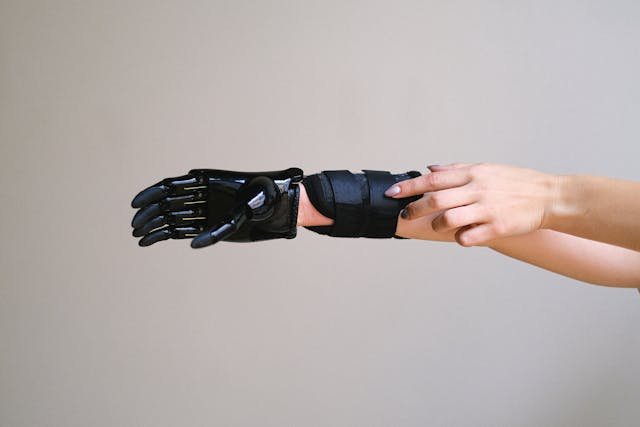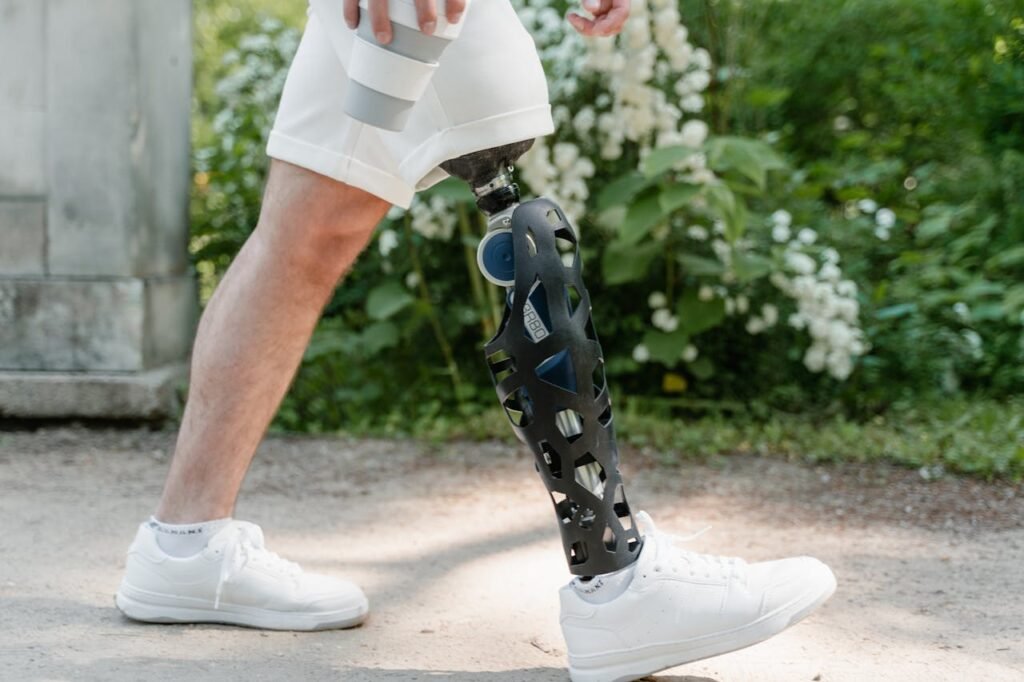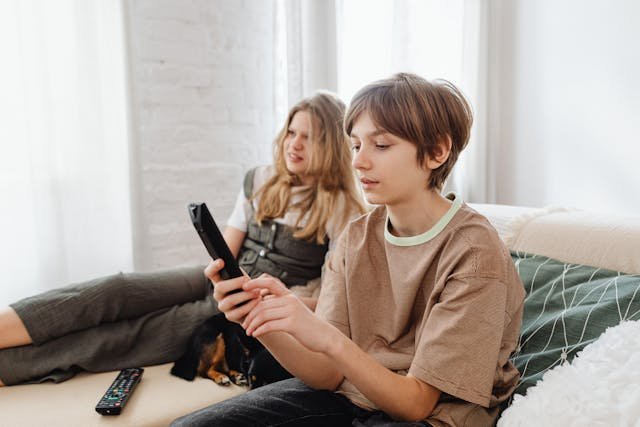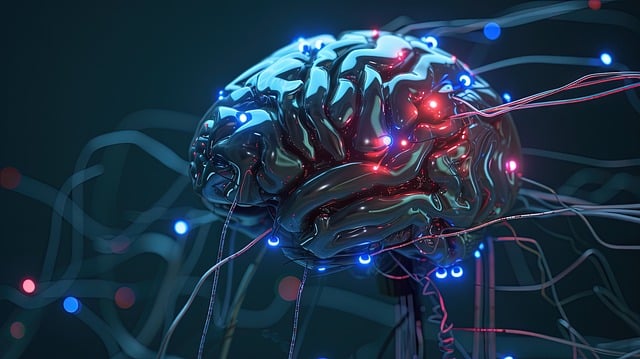Prosthetic limbs have come a long way from simple mechanical replacements to high-tech, AI-powered devices. But the most groundbreaking advancement yet is neural-controlled prosthetics, which allow users to move artificial limbs with their thoughts.
By 2025-2030, brain-integrated prosthetics will become more precise, intuitive, and widely accessible, restoring not just movement but also a sense of touch and natural control. This game-changing technology is giving people with limb loss more independence and mobility than ever before.
At Robobionics, we are committed to leading the way in neural-controlled prosthetic innovation, ensuring that users experience seamless control and real-time adaptability. In this article, we explore how brain-integrated prosthetic technology is changing lives, what advancements we can expect by 2030, and how this innovation is shaping the future of mobility.
1. What Are Neural-Controlled Prosthetics?
Neural-controlled prosthetics, also known as brain-integrated or brain-machine interface (BMI) prosthetics, are artificial limbs that connect directly to the nervous system. Instead of relying on mechanical movements or muscle contractions, these prosthetics work by reading brain signals and translating them into movement.
This is achieved through electrodes implanted in the brain or residual limb, which detect neural activity when the user thinks about moving their prosthetic limb. Advanced AI algorithms then process these signals and convert them into real-time prosthetic movement, creating a natural and fluid user experience.
By 2030, neural-controlled prosthetics will be widely available, allowing users to control their hands, arms, and legs with precision, speed, and ease—just like natural limbs.
2. How Brain-Machine Interfaces (BMIs) Enable Thought-Controlled Movement

Brain-machine interfaces (BMIs) are the key technology behind neural-controlled prosthetics, acting as a bridge between the brain and artificial limbs.
BMIs work by detecting tiny electrical signals from the brain or nerves and converting them into digital commands for the prosthetic limb. These systems use high-resolution electrodes, placed either on the scalp, inside the brain, or on remaining nerves in the residual limb.
Modern BMIs can continuously learn from user behavior, making movements more natural over time. For example, if a user struggles to grip an object, the AI will recognize this pattern and improve the limb’s response. By 2030, brain-machine interfaces will be even more refined, ensuring that thought-controlled prosthetics respond instantly and accurately to user intentions.
3. Restoring the Sense of Touch: The Role of Haptic Feedback
One of the biggest challenges with traditional prosthetics is the lack of sensory feedback—users can move their artificial limb, but they cannot feel what they’re touching. Neural-controlled prosthetics are solving this with haptic feedback technology.
Haptic feedback systems use electrical stimulation to send signals from the prosthetic limb back to the brain, allowing users to feel texture, temperature, and pressure. This means that by 2030, a person using a neural-controlled prosthetic hand will be able to tell the difference between soft fabric and a solid surface.
This breakthrough is not just about convenience—it’s about making prosthetic limbs feel like natural extensions of the body, improving grip control, object handling, and overall user confidence.
4. AI-Powered Learning: How Prosthetics Are Becoming Smarter Over Time

Artificial Intelligence (AI) is playing a crucial role in making neural-controlled prosthetics more intuitive and user-friendly.
AI-driven prosthetic limbs use machine learning algorithms to analyze movement patterns, grip strength, and walking styles, allowing them to adjust in real time. For instance, if a user struggles to pick up a delicate object, the AI will automatically refine grip control to prevent dropping or crushing it.
By 2030, AI-powered neural prosthetics will be capable of self-learning, meaning that the more a person uses their prosthetic, the better and more natural it will feel.
5. Wireless Connectivity: Controlling Prosthetics Without Wires
Traditional neural-controlled prosthetics often require wired connections to external computers, but wireless technology is changing that.
New developments in Bluetooth and high-speed neural transmission systems allow prosthetics to communicate wirelessly with the brain or residual limb nerves, eliminating the need for bulky external hardware. This means that by 2030, brain-controlled prosthetics will be completely wireless, making movement more natural, seamless, and user-friendly.
Users will also be able to adjust prosthetic settings through smartphone apps, ensuring personalized control with minimal effort.
6. The Role of Cloud Computing in Neural Prosthetics

Cloud technology is helping neural prosthetics become smarter and more efficient by allowing real-time data processing and updates.
With cloud-connected prosthetics, AI systems can analyze user behavior, predict movement patterns, and improve functionality automatically. This also means that prosthetists can provide remote adjustments, reducing the need for frequent clinic visits.
By 2030, cloud-enabled neural prosthetics will ensure that users always have access to the latest updates and performance improvements, making their artificial limbs more adaptive and long-lasting.
7. Ethical and Psychological Considerations: The Human Side of Brain-Controlled Prosthetics
While neural-controlled prosthetics offer incredible advantages, they also raise ethical and psychological concerns.
Users may experience adjustment challenges when transitioning to a thought-controlled limb, requiring mental and emotional support. Additionally, questions around data privacy, security, and brain signal storage will need to be addressed.
By 2030, support programs and mental health services will play a crucial role in helping users adapt to their brain-integrated prosthetic limbs, ensuring that the transition is as smooth and empowering as possible.
8. Making Neural Prosthetics More Affordable and Accessible

One of the biggest challenges with neural-controlled prosthetics today is cost. Advanced brain-machine interfaces can be expensive, making them inaccessible to many people. However, technological advancements and mass production are expected to significantly reduce prices.
With improvements in 3D printing, AI-driven manufacturing, and government subsidies, neural-controlled prosthetics will become affordable for a wider population. By 2030, these high-tech limbs will no longer be limited to a few—everyone who needs one will have access.
9. The Role of 3D Printing in Neural-Controlled Prosthetics
One of the key technologies making brain-integrated prosthetics more accessible and customizable is 3D printing.
Traditionally, prosthetic limbs had to be custom-made using expensive materials and labor-intensive techniques, leading to high costs and long production times. With 3D printing, prosthetic components can be designed, adjusted, and printed in a matter of hours, allowing for faster production and a perfect fit for each user.
By 2030, 3D-printed neural-controlled prosthetics will be the norm, ensuring that these advanced artificial limbs are not just high-tech but also affordable, lightweight, and comfortable for everyday use.
10. Future of Neural-Controlled Prosthetics in Sports and Athletics
Athletes with prosthetic limbs have always faced unique challenges, but neural-controlled prosthetics are removing those barriers and even giving them a competitive edge.
New AI-powered brain-controlled running blades, bionic arms, and adaptive knee joints will allow athletes to compete at the highest level with enhanced speed, strength, and endurance. Sensors will track muscle fatigue, energy efficiency, and movement precision, ensuring better performance and injury prevention.
By 2030, brain-integrated prosthetics will make sports more inclusive, enabling paralympic and adaptive athletes to push their limits like never before.
11. The Role of Neuroplasticity in Neural Prosthetics

Neuroplasticity—the brain’s ability to rewire itself and adapt to new experiences—plays a crucial role in the success of neural-controlled prosthetics.
Over time, as users interact with their brain-integrated limbs, their brains develop stronger connections with the prosthetic, making movement more fluid and natural. AI-driven neuroplasticity training programs will help users strengthen these neural pathways faster, improving reaction speed, accuracy, and comfort.
By 2030, neural-controlled prosthetics will become second nature, feeling just like biological limbs thanks to advanced neuroplasticity-based rehabilitation programs.
12. The Future of Fully Autonomous Neural Prosthetics
The ultimate goal of brain-controlled prosthetics is to create fully autonomous limbs that function just like real ones—without delays, recalibrations, or manual adjustments.
Future neural-controlled prosthetics will:
- Automatically adapt to different activities, such as walking, running, or climbing stairs.
- Adjust grip strength, step force, and muscle tension in real time based on neural feedback.
- Self-repair minor damage using bioengineered materials, reducing the need for maintenance.
By 2030, neural prosthetics will no longer feel artificial—they will be indistinguishable from natural limbs in both function and appearance.
Real-Life Case Studies:
Neural-controlled prosthetics are no longer just science fiction—they are transforming lives around the world. With brain-machine interfaces (BMIs), AI-driven learning, and haptic feedback, people with limb loss can now control their prosthetic limbs using only their thoughts.
Here are some real-life case studies that highlight how this groundbreaking technology is improving mobility, independence, and quality of life.
1. The First Man to Feel with a Prosthetic Hand

Background
Nathan Copeland lost feeling in his hands after a car accident left him paralyzed from the chest down. Even though he could move his prosthetic hand with his brain, he couldn’t feel anything he touched—until researchers introduced haptic feedback technology into his prosthetic limb.
Breakthrough
Scientists implanted microelectrodes into Nathan’s brain, which allowed his prosthetic hand to send sensory signals directly to his nervous system. When he touched an object, he could feel pressure and texture, making it the first time a paralyzed person regained a sense of touch through a prosthetic.
Impact
Nathan can now grip objects more accurately and perform delicate tasks, proving that neural-controlled prosthetics aren’t just about movement—they’re about restoring human sensation.
By 2030, haptic feedback will become a standard feature in neural-controlled prosthetics, making artificial limbs feel as natural as biological ones.
2. Thought-Controlled Prosthetics Help a Soldier Return to Everyday Life
Background
Johnny Matheny, a former U.S. Army soldier, lost his arm to cancer. He was one of the first people to receive a neural-controlled prosthetic arm, which he could control using his brain without any external buttons or manual input.
Breakthrough
With a BMI implant connected to his prosthetic, Johnny’s brain signals were translated into real-time movement. Unlike traditional prosthetics, which rely on muscle contractions, this arm allowed him to simply think about moving his fingers, and they would respond instantly.
Impact
- Johnny can now perform everyday tasks like shaking hands, holding a cup, and even driving.
- His prosthetic is adaptive, meaning it learns his movement patterns over time, making actions smoother and more natural.
- His success has paved the way for more veterans and amputees to receive brain-controlled prosthetics in the future.
By 2030, neural prosthetics will allow many amputees to regain not only mobility but also independence, making artificial limbs as intuitive as real ones.
3. A Woman Regains Natural Walking Ability with a Brain-Controlled Leg

Background
After a motorcycle accident, 32-year-old Sarah Johnson lost her right leg above the knee. Traditional prosthetic legs were difficult to use, requiring manual adjustments and causing fatigue over long distances.
Breakthrough
Sarah was part of a clinical trial for brain-integrated leg prosthetics. Researchers implanted electrodes into the nerves of her residual limb, allowing her brain to control the artificial leg just like a natural one.
Impact
- Sarah can now walk, climb stairs, and run effortlessly, thanks to AI-powered motion tracking.
- Her prosthetic knee and ankle adjust in real-time, making walking feel natural instead of robotic.
- She no longer experiences phantom limb pain, as her brain recognizes the prosthetic leg as part of her body.
By 2030, brain-controlled leg prosthetics will replace traditional models, allowing amputees to walk with zero delays and greater endurance.
4. The First Mind-Controlled Bionic Arm with Multi-Grip Functions
Background
A former chef, Luis Garcia, lost his right arm in a workplace accident. Using a traditional prosthetic was frustrating because it had limited movement and required manual adjustments.
Breakthrough
Luis became the first patient to receive a multi-grip, brain-controlled bionic arm. His prosthetic:
- Reads neural signals in real-time and adjusts grip strength based on what he’s holding.
- Recognizes over 20 different movements, from holding a knife to using a computer mouse.
- Includes haptic feedback sensors, allowing him to feel the shape and texture of objects.
Impact
- Luis returned to cooking professionally, proving that neural-controlled prosthetics can restore careers and hobbies.
- His prosthetic learns from his daily activities, making tasks smoother and more intuitive.
- He now performs complex movements with precision, like peeling vegetables or handling delicate food items.
By 2030, mind-controlled prosthetic arms will allow users to perform delicate, everyday tasks without conscious effort, making artificial limbs functionally identical to real ones.
5. The World’s First Fully Wireless Neural Prosthetic
Background
Mark Reynolds, an engineer, lost his hand in a construction accident. He was frustrated with wired brain-controlled prosthetics, which required external headsets and bulky hardware.
Breakthrough
Mark was fitted with the first completely wireless brain-controlled prosthetic hand. This breakthrough allowed:
- Instant thought-to-movement response with no external wires.
- A discreet, implantable brain chip that connected seamlessly to his prosthetic.
- Full smartphone integration, letting him adjust settings with voice commands.
Impact
- Mark can now control his prosthetic without any visible hardware, making it feel more natural.
- His prosthetic is connected to the cloud, allowing AI-driven software updates to improve movement over time.
- This technology is paving the way for wireless neural prosthetics to become widely available by 2030.
By 2030, all neural prosthetics will be fully wireless, eliminating cumbersome external controls and making artificial limbs feel more like natural body parts.
Final Thoughts: The Future of Neural-Controlled Prosthetics
The next five years will mark a turning point in prosthetic technology. With brain-machine interfaces, AI-powered learning, haptic feedback, and wireless connectivity, neural-controlled prosthetics will become more advanced, intuitive, and life-changing than ever before.
At Robobionics, we are committed to bringing the future of prosthetic technology to life, ensuring that our users experience seamless movement, real-time adaptability, and a truly natural feel.
If you’re excited about the possibilities of next-generation brain-controlled prosthetics, book a free demo with Robobionics today and step into the future of seamless, thought-powered mobility!



